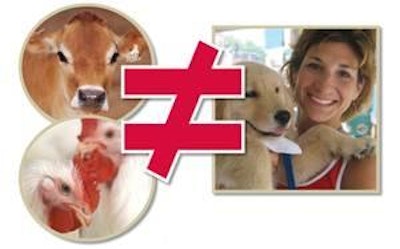
The battle for the hearts and minds of the American consumer between the animal rights movement and animal agriculture is not going well, according to Dr. Wes Jamison, associate professor of communication, Palm Beach Atlantic University.
Jamison told an audience at the International Poultry Expo, “I have been studying the animal welfare animal rights movement for over two decades and I want to tell you one thing, you are losing.
“If you think that you can win this battle using science and economics, you are doomed, because the public doesn’t listen to science and economics,” Jamison said.
The industry must have science and economics on its side to stay in business in the private sector, but more is needed to win a war of ideas and images with animal rights groups.
Dogma for the post-theological age
The Humane Society of the United State (HSUS) began the “animals and religion” campaign a few years ago, and the tactics and messaging the organization is using has shown to be effective with test groups. Animal rights groups turned to religion, Jamison said, because they believe this is a winning strategy.
Peter Singer, a philosopher and animal rights advocate, said in 2002 that the animal rights movement in the U.S. needed to co-opt Christianity or it would fail, Jamison reported. He quoted the philosopher Nietzsche who said, “Once God is dead, religion is a tool to mobilize the masses.” In what Jamison characterized as today’s post-theological age, many people’s morality is relative and flexible, but linking a cause to religious arguments can give the aura of objective truth.
In American politics, change requires a sustained intensity and nothing provides this like religion, according to Jamison. “Behavioral change is easier with religious arguments,” he said.
“What we see is a concerted effort by a sophisticated group (HSUS) to try and co-opt religious arguments,” he said.
Animal rights groups, he said, have been very good at framing issues so that animal agriculture can’t win them. Once the issue is framed a particular way it is difficult to address it a different way.
“Why even talk about religion to a secular group of poultry farmers and poultry executives? Because, if your opponents are able to frame this debate in religious terms and use morality against you then you will have a very difficult time responding with science and economics,” he said.
“Consumers own pets and treat them like surrogate humans,” Jamison said. “They have one animal in the center of their heart and another animal at the center of their plate.” HSUS’s motive is to make people feel guilty over treating one animal as a companion and the other as cuisine.
Carnivorous pet-owners dilemma
HSUS is targeting the “pan-religious, squishy, middle-millennial pet-owner,” according to Jamison. HSUS creates a guilty feeling for pet-owners since they treat their pets one way and food animals are treated another way.
“You are a hypocrite if you do this,” Jamison said. “God makes no such distinctions between pets and farm animals. Guilty feelings come in anytime these people eat meat. Then they need to do something to assuage their guilt.” Finally, HSUS offers the consumer an opportunity to make atonement and assuage their guilt; they can donate time or money to HSUS.
HSUS wants to engender compassion for farm animals, amplify guilt, and then motivate support by a call to action. Jamison said that in his tests with pet owners, the HSUS images work. He described the HSUS campaign as secular indulgence, just like an environmentalist buying carbon credits to offset vacation travel.
Counter-strategies
Jamison said that the public is listening to animal rights advocates as it tries to add morals to the debate, but he said that this is a winnable debate. “The bible says that you can not only eat animals but enjoy doing it,” he said. “We have forgotten in our culture that something has to die so that we can live. We have to empower our consumers to feel good about using our products. All our side has to do is say it is OK, and we win.”
Once again, Jamison stressed that science and economic messages will not win this debate. He said that farmers have to be out front in communicating with consumers and that we need to reconnect people to their food supply.
Jamison said that the message, “Consumers trust us to bring America’s animals from farm to family and we take this sacred trust seriously,” when communicated by a farmer, scored well with consumers.
Consumers should be shown images of what really happens in the processing plant, warts and all, according to Jamison. He said that any shock consumers have initially wears off and that consumers can be inoculated against negative messages and images presented by industry opponents.
An anti-politically correct messaging campaign on college campuses showed promise, he reported. Fraternity brothers were given “I Love Meat” t-shirts, which the fraternity members knew intuitively would chap the campus vegan and environmental group members.
The “It’s Simple” campaign was also effective, according to Jamison. The statement, “Dog ≠ Cow,” accompanied with cartoon images of a cow and dog, resonates with consumers. The subtle message is that if you don’t get this, then you are not part of the mainstream.
“Consumers like your products, they like the quality and they like the price,” Jamison said. “This is a winnable issue.”
The animal rights movement is making consumers feel guilty, but agriculture can let consumers enjoy animal products, guilt-free, if agriculture decides to join the conversation.




.jpg?auto=format%2Ccompress&fit=crop&h=167&q=70&w=250)












